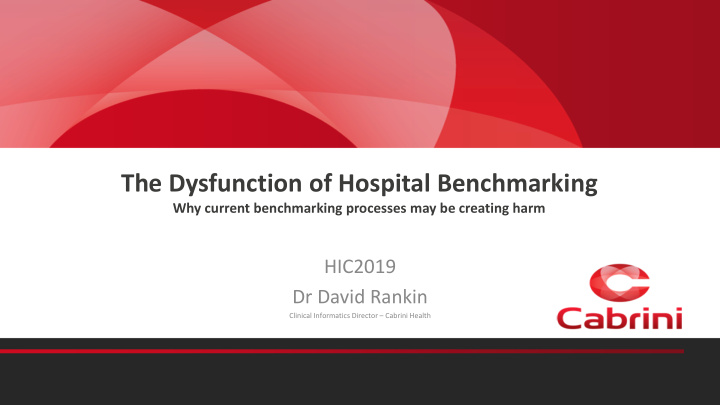



The Dysfunction of Hospital Benchmarking Why current benchmarking processes may be creating harm HIC2019 Dr David Rankin Clinical Informatics Director – Cabrini Health
Why Benchmark • Foster improved clinical outcomes • Competitive Positioning • Attract new business • Generate patient confidence • Determine value • Centre of Excellence • Negotiate preferential price • Compliance • Contractual requirement • Meet accreditation criteria Benchmarking is critical and integral to quality improvement
Cabrini’s Multiplicity of Agencies • Independent Hospital Pricing Authority (IHPA) • Victorian Agency for Health Improvement (VAHI) • VICNISS (Healthcare Associated Infections) • Australian Council on Health Standards (ACHS) • Health Round Table (HRT) • Catholic Negotiating Alliance (CNA) • Health Insurers (Medibank) • Australian Rehabilitation Outcome Centre (AROC) • Palliative Care Outcome Centre (PCOC) • Registries • ANZICS, Joint Registry, Bariatric, Cardiac, etc
Multiplicity of Indicators Indicator Groups Indicators ACHS 20 324 HRT 5 73 (includes 16 HAC) CNA 6 46 VAHI 4 16 How many indicators can a reasonable organisation focus on?
Variable Participation • VAHI • 67 private hospitals • 8 Acute Group A Hospitals • Catholic Network Alliance • 33 private hospitals • 6 large private hospitals • Health Round Table • ~200 hospitals (5 private) • 2 Acute Group A Hospitals • ACHS • 608 hospitals (307 private) • 27 large private hospitals • Participation rate ranges from 1 – 223 private hospitals
Variance in Algorithms • Exclusions used in various agency algorithms • Age 95 and over • Palliative care • Day patients • Mental Health • Chemotherapy, haemodialysis, radiotherapy • Emergency admissions • Ungroupable DRGs (DRG 9) • Organ donors • Rehabilitation • Paediatric • Unqualified newborns • “Planned” readmissions, ICU admissions • Length of Stay > 200 days • Deaths in hospital
Planned/Unplanned • Urology (ureteroscopy and stone ablation) • Stent removal • Required 7 – 14 days post discharge • Scheduled • Repeat ablation • Expected, but conditional • Multiple (3+) implies poor technique • Haemorrhage • Anticipated but not expected
Variance in Cost • Financial • Ranges from $45,000 income to $150,000 cost per year • Extraction • Manual data extraction • Data filtering, cleansing, validation • Data submission • Data correction • Reporting • Training • Interpretation, research, explanation
Variance in Results HSMR VAHI HRT Malvern 65 2.1 Peer 92 2.6 Pressure ACHS CNA HRT Injuries Malvern 0.129% 0.12 0.9 Peer 0.071% 0.66 3.2 HAC Medibank VAHI CNA HRT Malvern 6.3 1.9 4.7 2.2 Peer 4.8 1.5 3.5 2.6
Data Sources & Data Quality • PAS • Coded data • Based on medical documentation • Riskman • Observed data • Variability in reporting, completeness, consistency • Provider supplied • Laboratory records • Specialist supplied • Intended MBS codes • Theatre recorded MBS codes • Medicare billed MBS codes
Adjustment • Case mix adjustment • Age • Diagnosis • Complexity • Acuity • Peer • Selection and identification of peers • Size, case mix, ownership, geographic, funding structure • Frailty • Strong correlation with dependency and complexity • Not currently collected
Ideal State • Defined set of core hospital sector indicators • Facility specific stratifications • Public/Private • Hospital Size – peer clustered • Overnight/Day stay • Standard definitions • Agreed and published by a trusted agency • Regular and meaningful provider and consumer input • Defined data sources • Numerators, Denominators clearly defined • Adjustment methodology consistently applied • Transparency • Defined reporting criteria and format
Does Benchmarking Create Harm? Concern that current state: • Undermines trust in the data and reporting • Provides clinicians with an excuse to ignore health data • Allows selective determination of comparators • Potentially allows misuse for competitive advantage • Seldom (if ever) available to clinicians • Requires intense training to interpret the reports
Summary • Benchmarking is essential to continuous quality improvement • Require only a small set of core clinical indicators • Focus on fixing the material variance • Indicators should be universal and comparable • Reports should be: • Clinically useful (generate provider reflection) • Engaging (easily understood) • Transparent (available)
Recommend
More recommend